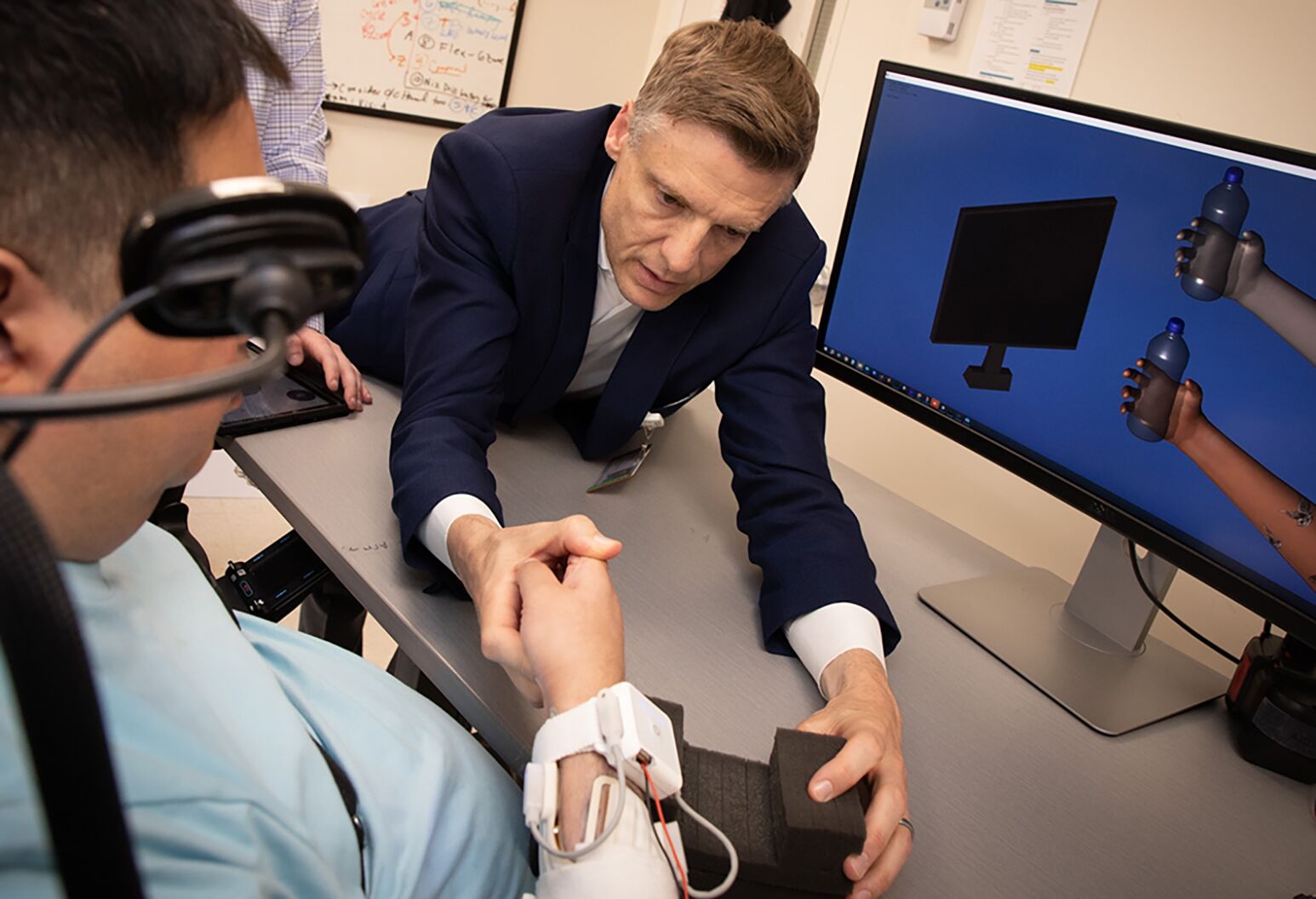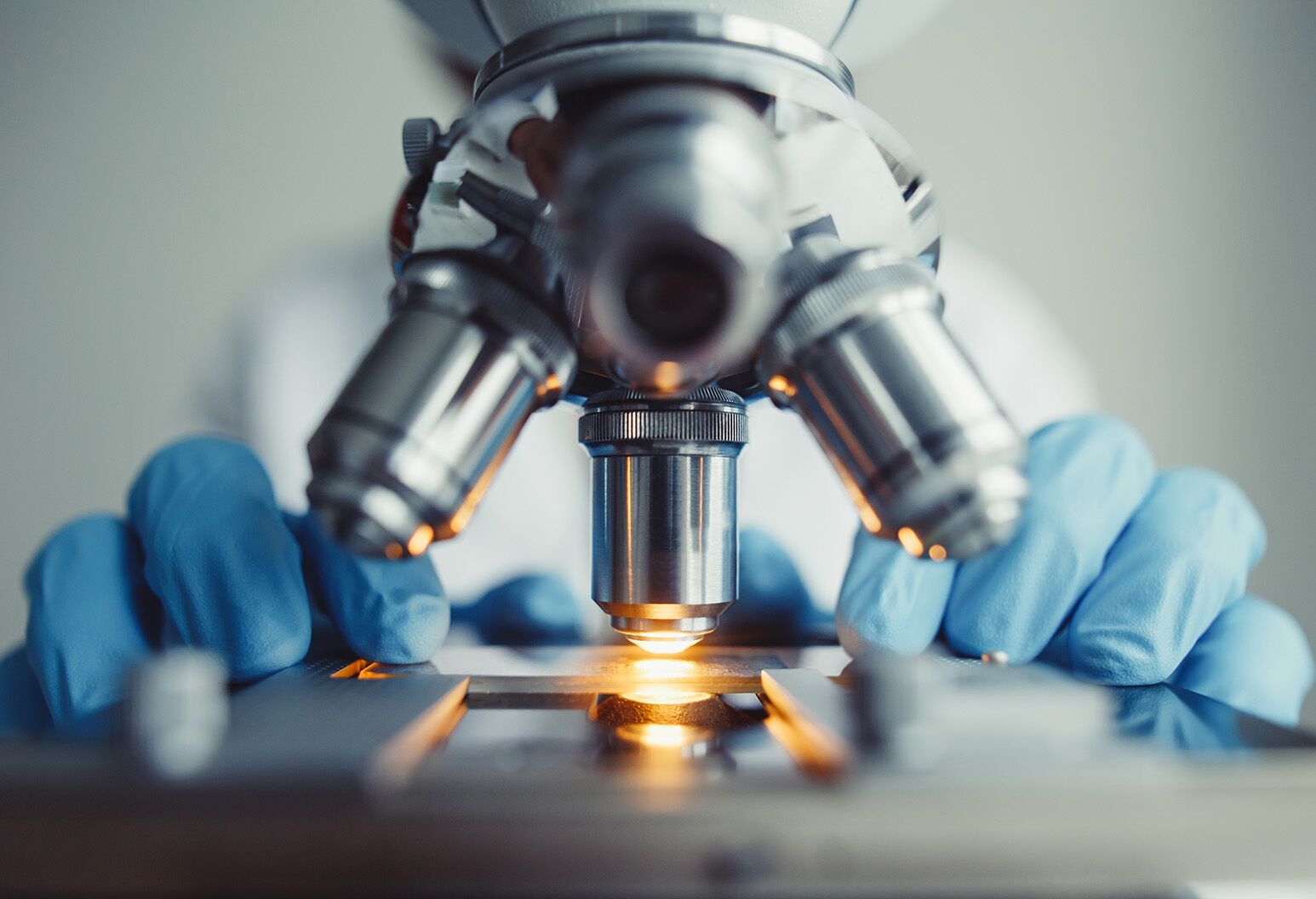The Feinstein Institutes—the research institutes of Northwell Health, New York’s largest health care provider—is home to 50 research labs, 3,000 clinical research studies and 5,000 people raising the standard of medical innovation. We make breakthroughs in molecular medicine, genetics, cancer, brain research, mental health, autoimmunity and bioelectronic medicine.
Insights
Zapping the body electric

In the new field of bioelectronic medicine, vagus nerve stimulation is replacing medication
Thirty years ago, a young neurosurgeon had an experience that changed his life, his career and, possibly, the course of medicine. The doctor was Kevin J. Tracey, MD, who would go on to become president and CEO of the Feinstein Institutes for Medical Research.
Deep into his medical training, Dr. Tracey had already treated patients who’d experienced gunshot wounds, devastating falls, car accidents. But he was unprepared for the tragedy that, in 1985, struck a small patient named Janice.
Less than a year old, Janice was crawling across the kitchen foor in her family’s home as her grandmother turned to drain a pot of pasta into the sink. Her grandmother stumbled, and the boiling water flooded over the baby. Janice’s entire body was scalded.
For a month, Dr. Tracey treated Janice in the burn unit. Miraculously, she seemed to be improving — so much so that the medical team began to consider discharging her. But one morning, without warning, she went into shock. Dr. Tracey cradled her in his arms and administered mouth-to-mouth resuscitation; the team ran a frantic code. But it was no use. A year and a day old, Janice was dead.
“It was horrible, and what made it even worse was that I couldn’t tell her parents why it had happened,” says Dr. Tracey, who is the Karches Family Distinguished Chair in Medical Research. “Science simply didn’t understand why septic shock occurs.”
Grieving and frustrated, Dr. Tracey decided to shift his focus to research as well as neurosurgery. He was going to find the trigger for septic shock.
That started a string of discoveries. First came the realization that bacteria didn’t cause shock, at least not directly; instead, infection could lead to overproduction of an immune system molecule called tumor necrosis factor (TNF), which set off a cascade of internal changes. Then Dr. Tracey and his team injected an anti-TNF medication into the brains of rats to block the molecule there — only to find that they’d also blocked it in the heart, gut, liver and spleen. Somehow, the brain was controlling the release of TNF throughout the body, and through that, the activity of the immune system in organs from head to toe.
“Some people would call that the Eureka moment,” he says. “It was really more like a holy crap moment. And when we realized that the brain had this impact by way of the vagus nerve — that was the discovery that changed everything for me.”
The revelation opened up a tantalizing possibility. The vagus nerve runs down the side of the neck to all the organs of the body; now, it seemed like it was an information superhighway, carrying instructions from the brain. If the vagus nerve operated as an off switch for an overactive immune system, perhaps researchers could find a way to flip that switch using a small, implanted stimulator. Then doctors might be able to put aside their pharmaceuticals and use electronic stimulation — bioelectronic medicine — to instruct organs to behave in a healthy manner.
Over the past couple of decades, that insight has had an enormous impact. Researchers at the Feinstein Institutes and elsewhere have begun to build a granular understanding of the body’s neural networks, creating a map that can be used to direct the placement of devices. They’ve built an architecture of collaboration with scientists at the National Institutes of Health (NIH), the Defense Advanced Research Projects Agency (DARPA), and academic institutions and pharmaceutical and device makers around the world. They’ve helped run trials of treatments for chronic and acute diseases, in some cases yielding profound improvements for people with seemingly untreatable problems, from life-threatening infammatory bowel disease to spinal cord injury and paralysis. And all this is just the beginning.
How did we get here, and what comes next? What follows is a look at a few of the key steps toward a revolutionary rethinking of health and disease — and a glimpse at the future of medicine.
2000: An on/off switch for inflammation
Spurred by his experience with Janice, Dr. Tracey began to piece together the process that leads to septic shock, the condition that had killed her. He and his colleagues figured out that the immune system triggers septic shock by releasing TNF. And in 1987, they published their fndings that a monoclonal antibody that targets TNF can shut down the lethal cascade.
“That was very exciting, since it meant that monoclonal TNF antibodies could be used as therapy for inflammatory conditions, like rheumatoid arthritis and Crohn’s disease,” Dr. Tracey says. “Now they’re responsible for tens of billions of dollars in drug sales every year.”
Then came the discovery that blocking TNF in the brain also blocked it in organs throughout the body — meaning the brain has control over the immune system. But how? Finally, in 2000, in a study published in Nature, Dr. Tracey and his team confirmed that in rats with a raging infection, electrically stimulating the vagus nerve could prevent the production of TNF and ward off shock.
“That experiment demonstrated that the brain reflexively controls the inflammatory response throughout the body via the vagus nerve, just as it controls our heart rate and other vital functions,” Dr. Tracey says. “This seemed so simple, and in a way so obvious, that we were sure someone else must have already thought of it. But we checked the literature, and there was nothing.”
The possibilities were stunning. At lunch with Ralph Nappi, Northwell’s executive vice chair and the former chair of the board at the Feinstein Institutes, Dr. Tracey sketched the most exciting of them on a napkin: By implanting a small device to stimulate the vagus nerve, you should be able to prevent inflammation throughout the body, along with the diseases it causes. Soon, his team published the hypothesis in Nature that electrons might one day be able to replace drugs.
2011: An early success
As soon as the inflammatory reflex was identified, researchers began laying the groundwork for studies to see if vagus nerve stimulation (VNS) could provide relief to patients with inflammatory disease. There was much to figure out before trying the approach in humans, such as untangling exactly how the vagus nerve exerts its control. Painstakingly, scientists traced cause and effect: Electrical signals prompt the release of chemical messengers, which activate other cells, which trigger the production of more chemicals — which turns off the production of the inflammatory molecule, TNF.
With that understanding, it was time, in 2011, for a trial of VNS in patients with rheumatoid arthritis, led by SetPoint Medical.
That disease may sound like a mere irritant, but at its worst, rheumatoid arthritis can cause crippling joint damage and compromise a variety of body systems, including the lungs, heart and blood vessels, increasing the risk of heart attack and stroke. The patients enrolled in the study were severely ill. But with the VNS device firing for just a few minutes each day, their levels of damaging immune cells quickly dropped and stayed low. One patient, who’d often been unable to dress herself for work, began riding her bike 20 miles to the coast on weekends. Another, who had been confined to his couch for years, took up tennis.
“Seeing these effects in these patients who’d been suffering for so long was incredible,” says Dr. Tracey. “I was over the moon.”
2015: A center for exploration
Bioelectronic medicine is a way of thinking about health and disease that opens avenues to new kinds of therapies. To facilitate that process, in 2015 the Feinstein Institutes established the Institute of Bioelectronic Medicine (then called the Center of Bioelectronic Medicine), bringing together experts in molecular medicine, neuroscience and bioengineering. “These three disciplines are fundamental to our field,” says Yousef Al-Abed, PhD, co-director of the institute. “They allow researchers to map the body’s neural networks, identify targets in the brain or organs that, if dysregulated, cause disease, and then design devices that modify the instructions those targets receive so they start to function in a healthy way.”
2017 “Thank you for saving my life"
As the early study on rheumatoid arthritis study progressed, news of the promising results began reaching patients struggling with other inflammatory disorders. One of those patients was a young woman named Kelly Owens, who was searching for anything that might help with her intractable case of Crohn’s disease.
The condition had wreaked havoc on Owens’ life. In constant pain from inflammatory arthritis and suffering from gaping skin ulcers, she’d had to quit her job as a teacher. She’d been on 22 medications, but only high-dose steroids provided lasting relief — and those meds left her with osteoporosis.
Owens first reached out to Dr. Tracey in 2014, but at that point there were no clinical trials of VNS for Crohn’s disease. By the time her condition became truly dire, one had been launched — but she would need to move to Amsterdam to participate. Undaunted, Owens and her family put together a GoFundMe page so she and her husband could relocate.
Owens received an implant in July 2017, while participating in a SetPoint Medical clinical trial, and began to feel better almost immediately. “Within a few weeks, my knees had gone from the size of cantaloupes to totally normal,” she later told Prevention magazine. By September 1, she was in remission.
Later that month, she sent an email to Dr. Tracey. “Thank you for saving my life,” the subject line read. Owens’ pink walking cane now sits in Dr. Tracey’s office, a visible reminder of the life-changing impact of this research. (She later became director of education and outreach at the Feinstein Institutes.) “This is why we do it,” Dr. Tracey says. “This is what it’s all about.”
2021: Targeting obesity
More than 650 million adults worldwide are obese, raising their risk of a wide range of disorders, including heart disease, diabetes, stroke and many types of cancer. Although some treatments are available, the most effective ones are either invasive (like bariatric surgery) or expensive, difficult to access, and require a lifelong commitment (like the new anti-obesity drugs). But bioelectronic medicine may offer a promising alternative.
Collaborating with scientists at GE Research in a study on mice, Sangeeta S. Chavan, PhD, a professor in the Institute of Bioelectronic Medicine at the Feinstein Institutes, and graduate student Tomas Huerta used targeted ultrasound to stimulate the liver. The study was particularly exciting because it involved very precise neural targeting: Rather than stimulating the vagus nerve, the researchers aimed ultrasound energy at specific neural circuits in the organ.
“This noninvasive stimulation, delivered in two bouts daily of just two minutes each, reduced body weight, suppressed the desire to eat more and improved insulin resistance,” says Dr. Chavan, a researcher in the Tatyana and Alan Forman Family Laboratory of Biomedical Science. “These findings represent the unrecognized potential of ultrasound stimulation to treat obesity-related complications without pharmaceuticals.”
A later clinical trial, in 2023, provided a glimpse of how noninvasive focused ultrasound stimulation could work in people. Dr. Chavan and Feinstein Institutes researcher Stavros Zanos, MD, PhD, along with GE Research scientists, delivered either spleen-focused ultrasound stimulation (FUS) or sham stimulation to 70 healthy volunteers. The spleen FUS had an anti-inflammatory effect, lowering TNF production for more than two hours.
“We know inflammation plays a major pathogenic role in many diseases and conditions,” Dr. Zanos says. “So these first-in-human results of this non-invasive intervention are exciting.”
2023: Controlling bleeding in and out of the OR
As a trauma surgeon, Jared Huston, MD, is acutely aware of the danger that bleeding can pose. “If you’re injured in a trauma, the most common preventable cause of death is uncontrolled bleeding,” says Dr. Huston, who is associate professor of surgery and science education at the Donald and Barbara Zucker School of Medicine at Hofstra/Northwell and the Institute of Bioelectronic Medicine at the Feinstein Institutes. Accidents aren’t the only circumstance that raise the risk of catastrophic bleeding. Postpartum hemorrhage is the leading cause of maternal mortality worldwide. And people with hemophilia — an inherited blood disorder in which lack of clotting factor makes the blood clot less easily — can suffer chronic pain from bleeding into their joints and, in severe cases, face an increased risk of death.
That’s why Dr. Huston has been working on a “neural tourniquet,” which uses VNS to prevent or stop hemorrhage. How it works: VNS targets fibers of the vagus nerve that communicate with the spleen, because that’s the organ responsible for prepping platelets to form clots. After the stimulation, Dr. Huston says, the platelets are primed to work more effectively. “In animal studies, we’ve seen traumatic blood loss decrease by 75 percent,” he says.
The most recent study demonstrates the power of the approach in treating hemophilia. In mice with the bleeding disorder, VNS reduced bleeding just as well as infusions that replace the missing clotting factor.
“These are exciting results, not just for those living with hemophilia, but also for people at risk for excessive bleeding in the OR, on the battlefield, in a highway accident or during childbirth,” says Dr. Huston. “In all these circumstances, a simple, handheld device may someday be all it takes to shut down bleeding and save lives.”
2023: Bypassing paralysis — bioelectronically
On July 18, 2020, 42-year-old Keith Thomas suffered a disastrous accident in a friend’s pool when an overly aggressive dive damaged his spinal cord and left him paralyzed from the chest down. Almost three years later, in March 2023, a team at the Feinstein Institutes used a double neural bypass — a form of bioelectronic medicine — to help him begin to move and feel again.
The double neural bypass uses brain implants, artificial intelligence and stimulation electrodes placed over the patient’s arm and spinal cord. Led by Chad Bouton, professor and vice president of advanced engineering at the Feinstein Institutes, the researchers carefully mapped Thomas’ brain and implanted five tiny microchips. These enabled the team to intercept brain signals and reroute them — both to the part of the body for which they were intended and to the spinal cord to strengthen critical neural connections.
Electrodes placed on Thomas’ arm activate his muscles, allowing his fingers and hands to move; sensors on Thomas’ fingertips and palms send information back to his brain, restoring a sense of touch. Spinal cord stimulation has doubled his arm strength, allowing him to lift a cup to his mouth and take a drink in response to his thoughts. In recent months, researchers have even observed signs of sensation after stimulation has been turned off, says Prof. Bouton, in the Karches Neural Bypass and Brain-Computer Interface Laboratory. “This approach holds immense promise for helping the millions of people living with paralysis regain their ability to move and to feel again.”
For Dr. Tracey, the work he sees all around the Institute for Bioelectronic Medicine is the gratifying payoff of the pledge he made as he struggled fruitlessly to save a little girl’s life — the commitment to understand the molecular mechanisms behind disease, and to find a way to intervene. “The idea of using technology to replace medications and treat disease is no longer science fiction. It’s happening today,” he says. “I believe that thanks to bioelectronic medicine, more and more diseases will be brought under control — so little girls like Janice can grow up and thrive.”




